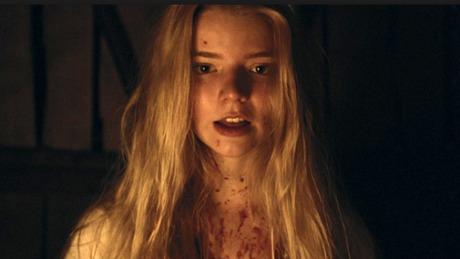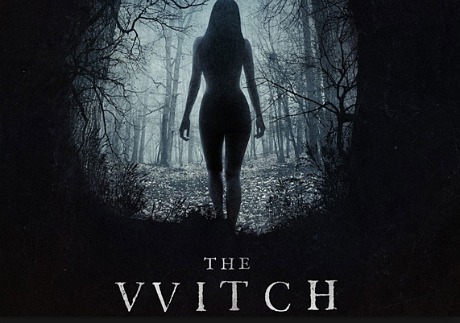Click here to jump past HE Sink-In


Horror is viral, waiting in the blood. How to release it? Easy — deliver the shocks, summon the grotesque, bare the fangs, drool the saliva, screech the soundtrack…the usual bag of tricks. Delivering a half-decent fright flick is within the abilities of most marginally talented directors. But it takes an exceptional wizard to finesse things in a subliminal way…to instill something that creeps and crawls beyond the corner of your eye…a slightly demonic something-or-other that is elusive and yet deliberate and merciless as fuck.
Even more exceptional (and pretty close to unique) would be a period horror film that operates according to the myths of its day, that eschews the reliable Wes Craven devices in favor of resuscitating nightmares that terrified the hell out of modest, rational people three or four centuries ago…goats, crows, claws, beaks, witches and even the most fleeting thoughts of sex out of wedlock or even, you know, sexual notions about your own sister or daughter. Out, demon!
This is what Robert Eggers‘ The Witch (A24, 2.19) does and then some. Set on a small New England farm in the early 1600s, it delivers creeps and chills according to the myths and suppressions of its time. Which isn’t to imply it errs on the side of subtlety…far from it. It’s just playing a different game.
If your tastes run to the primitive, you’ll most likely say “Hey, where’s the usual scary-ass shit that I’m used to? C’mon..I paid for my ticket and my popcorn…lay it on me!” There’s no talking to people like this. It takes a sliver of sensitivity and a little bit of brain-cell percolation to get what The Witch is up to, and the fact is that animals like what they like, want what they want, and never the twain shall meet.
Here’s how I put it a month ago: “The Witch may be too good for some — too subterranean, too otherworldly, too scrupulous in its avoidance of cliches. And because it goes for chills and creeps rather than shock and gore.

I’ve long regarded Slate‘s David Ehrlich as one of the most annoying critics around — an ivory-tower navel gazer and Tarantino lover who lives in his own fickle rectum and only comes out for screenings and for groceries at the local Whole Foods. But I have to give him credit an exceptionally perceptive review of The Witch, a portion of which follows:
“Inspired by written accounts of historical witchcraft (a closing title card notes that much of the dialogue comes ‘directly from period journals, diaries, and court records’), The Witch establishes a terrific sense of authenticity, so that it can debase it with supernatural terrors. A former production designer with a meticulous eye for detail, Eggers creates a wholly cohesive world on a limited budget, his every flourish — like the careful thatch of a roof, or the Native Americans who drift into frame as William and his family are being carted away from civilization — helping to make this sliver of the 1600s feel as real to us as Satan does to the sorry characters who populate it.
“Combining the rigorous severity of Stanley Kubrick with the fevered paranoia of The Crucible, Eggers directs this episode of pre-Salem hysteria with an unblinking formalism that makes every shot feel like it’s daring you to look closer. (Even the animals he casts are the most demonic nonhuman actors in recent memory.) His straight-faced commitment to his film’s central conceit would feel silly and self-important if it weren’t shared by his cast.”
The focus is on a farming family of seven — a strong, devout father with a deep resonant voice (Ralph Ineson), a wiry, agitated, asexual mother with a mostly impenetrable accent (Kate Dickie), an intelligent and very hot mid-teen daughter named Thomasin (Anya Taylor-Joy), a younger brother disturbed by sensual stirrings (Harvey Scrimshaw), two toddlers (Ellie Grainger, Lucas Dawson) and an infant — and one of the most fearsome and persistent threats, never acted upon or spoken of but constantly flowing in the blood, is the animal energy of sex.

Particularly noteworthy in this regard is Anya Taylor-Joy, an actress-model who’s not quite 20 and was more like 18 when The Witch was shot in late ’14 or early ’15. I’m telling you she performs a scene of erotic possession at the very end that matches Mia Farrow‘s satanic mating scene in Rosemary’s Baby — it’s really something to see.
Ehrlich: “Her maturing body is as great a fount of evil as the woods outside her house. Oblivious to the lurid looks that her desperate brother casts at the lift of her blouse, Thomasin is nevertheless made to feel as though the devil lurks in her bones just as the witch resides in the forest, and when her father declares that his family ‘will conquer this wilderness,” it’s clear that his words are spiked with double meaning.
Final note: Amy film lover worth his or her salt will tell you that The Blair Witch Project (’99) is one of the all-time scariest films. And yet film critic Owen Gleiberman, on page 241 of his new book “Movie Freak“, recalls the following: “It became the most successful independent feature of all time, grossing $140 million (i.e., $32 million more than Pulp Fiction). And yet three out of every five people who saw it seemed to think it was the unscary/tedious letdown/ripoff of all time. Was everyone watching the same film? Yes and no. What The Blair Witch Project revealed was an American moviegoing population of blue states and red states, who happened to be seated right next to each other.”
I trust I’ve made it clear that The Witch is a blue-state horror film. The Babadook, It Follows…one of those. And one of the best of its kind because it (a) slavishly adheres to a very particular scheme and (b) reanimates a long-buried mythology that poked and terrified even those of a rational temperament. Fear is illogical, and it always has been.
